The Kingston A1000 NVMe SSD Review: Phison E8 Revisited
by Billy Tallis on July 2, 2018 8:00 AM ESTAnandTech Storage Bench - The Destroyer
The Destroyer is an extremely long test replicating the access patterns of very IO-intensive desktop usage. A detailed breakdown can be found in this article. Like real-world usage, the drives do get the occasional break that allows for some background garbage collection and flushing caches, but those idle times are limited to 25ms so that it doesn't take all week to run the test. These AnandTech Storage Bench (ATSB) tests do not involve running the actual applications that generated the workloads, so the scores are relatively insensitive to changes in CPU performance and RAM from our new testbed, but the jump to a newer version of Windows and the newer storage drivers can have an impact.
We quantify performance on this test by reporting the drive's average data throughput, the average latency of the I/O operations, and the total energy used by the drive over the course of the test.
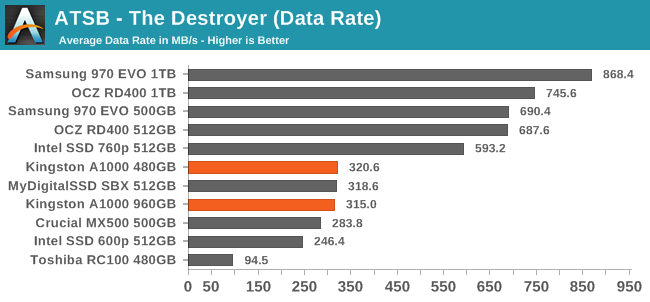
The average data rates from the Kingston A1000 on The Destroyer are only slightly above that of mainstream SATA SSDs. There's also essentially no performance difference between capacities, which isn't too surprising because even the 480GB model has plenty of NAND flash chips to keep all four channels of the controller busy. Performance differences from the MyDigitalSSD SBX are negligible.
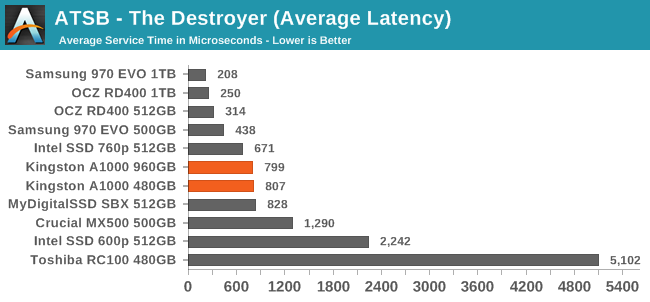

The average and 99th percentile latency scores from the Kingston A1000 are substantially lower than for SATA drives or other low-end NVMe drives like the Intel 600p and Toshiba RC100. The A1000 also has very slightly lower latency than the MyDigitalSSD SBX. Some of the more expensive PCIe x4 NVMe SSDs offer much better average latency, but for 99th percentile latency the A1000 is just a factor of two or three away from the best flash-based drives.
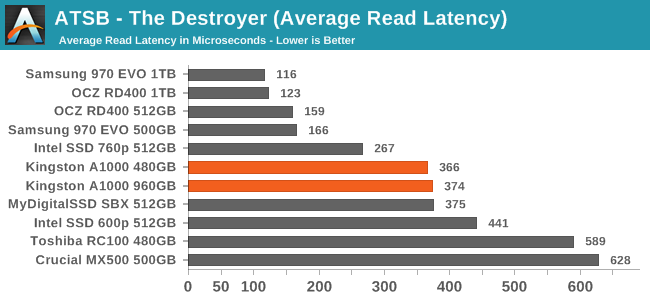
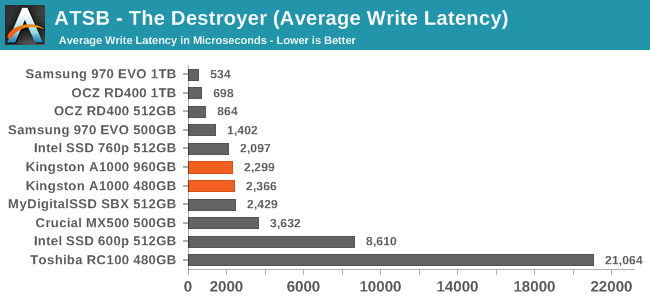
Average read latencies from the A1000 aren't as good as the best NVMe SSDs, but they're still just a fraction of a millisecond and clearly faster than typical SATA drives. Average write latency is much higher than the best NVMe drives but still reasonable for a low-end NVMe drive, with none of the severe write performance problems seen with the Intel 600p and Toshiba RC100.
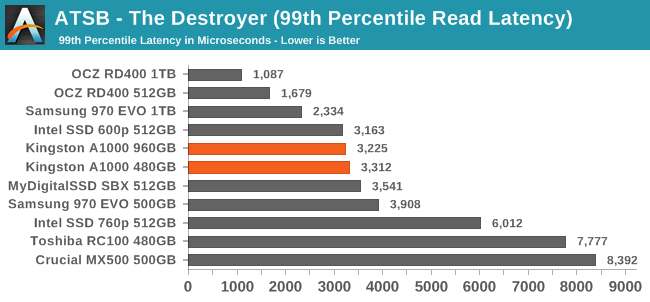
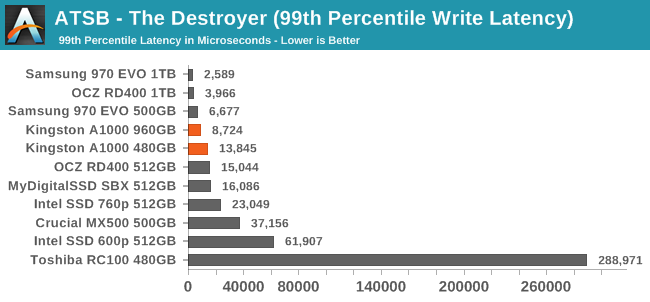
The 99th percentile read and write latencies from the Kingston A1000 are about as good as can be expected from a TLC-based drive; it even manages to slightly beat the Samsung 970 EVO for reads. The larger 960GB A1000 model has a substantially better 99th percentile write latency than the 480GB model.
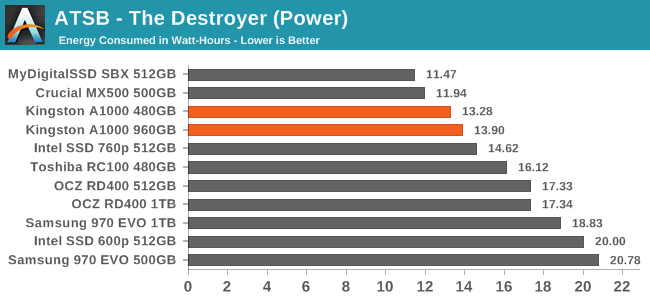
The larger 960GB Kingston A1000 uses a bit more energy over the course of The Destroyer than the 480GB model, and both use substantially more energy than the MyDigitalSSD SBX or the Crucial MX500. However, the A1000's power efficiency still compares favorably against the high-end PCIe x4 NVMe SSDs or the low-end NVMe SSDs that perform particularly badly on this long, intense test.










26 Comments
View All Comments
romrunning - Monday, July 2, 2018 - link
Any NVMe drive that doesn't beat the Intel 600p in every category shouldn't be made. I really wish all mfgs would keep NVMe drives to at least PCI x4 & 8 channels with a minimum performance level that is much higher than SATA. The bar for the next tech level of storage products should be at a higher level than the previous.Forget the low-end marked for NVMe. SATA can easily take care of any needs there.
peevee - Monday, July 2, 2018 - link
Given that only Samsung barely saturates PCIex2, and only on artificial tests, at this point even x4 is useless, let alone x8. They'll need many more channels.Actually, I'd prefer x1 for ultra-low-power, if it is fully saturated in more or less real-life tests (like AT's "Light"), vs x4 which only saturates 1/10th of x1 capacity.
romrunning - Tuesday, July 3, 2018 - link
I was thinking more along the lines of every mfg creating NVMe drives have to attain to a minimum performance level. It becomes easier to understand what is higher-performing from the end-user's perspective. So if NVMe's minimum performance level is 2x SATA, then anytime you see NVMe you know it's better than SATA. Too bad whatever storage consortium finalized specs for NVMe didn't require min perf levels for storage.It's annoy to me when these mfgs put out "new" drives that don't exceed the older tech.
FunBunny2 - Monday, July 2, 2018 - link
" I really wish all mfgs would keep NVMe drives to at least PCI x4 & 8 channels with a minimum performance level that is much higher than SATA. "some wag put it, "you sell the sizzle, not the steak".
Gunbuster - Tuesday, July 3, 2018 - link
Okay Kingston, reviews are done, feel free to swap in cheaper/slower NAND chips. ;)Ratman6161 - Tuesday, July 3, 2018 - link
In the ATSB Heavy Data Rate chart, for the 1TB 970 EVO, I think you have the full and empty numbers transposed. I.e. you show 525 empty and 635 full. I assume that should be 635 empty and 525 full?Billy Tallis - Tuesday, July 3, 2018 - link
They're not transposed. I'm not sure what happened with those test runs, but I'm re-running them. I do know that Samsung drives lie about when they've finished a secure erase, so it's possible the "empty" drive test run was still working on an erase operation in the background even though I try to ensure all drives have plenty of idle time to finish cleaning up after they claim to be done erasing.leexgx - Wednesday, July 4, 2018 - link
Surprised it works like that when using secure erase, zapping page area and all NAND chips should not take long to do, also what can i use to use secure erase on all drives (seagate own tool seems to lack it, it has full erase but it's not secure erase and it killed my seagate firecuda doing it)SanX - Tuesday, July 3, 2018 - link
Everyone here knows that in the shops the average Joe will see on the product tag "Sequential Read 1500 MB/s" which is plain lie and conveniently keeps mum about this. Which test gives 1500, show me? At best 2-3 times less.This site degraded long ago to serve salespeople.
rocky12345 - Wednesday, July 4, 2018 - link
Great review but this drive does seem rather unimpressive for sure. It acts like it doe snot have a dram cache at all since most if it's scores are well below the mark. I like Kingston for their memory products which work well in the systems I build for my clients. These NVMe drives that are considered lower end give a false picture of great speed and performance because NVMe drives are known for their great performance level. Then you get these drives trying to break into this sector and do not perform any where close to what you would expect from a NVMe drive. Heck my samsung 860 Pro 512GB Sata SSD can get better numbers in a lot of the tests done in the review than these cheap low end NVMe drives and it is only based off of the Sata port and limited to a max 600MB's from the port itself that is kinda sad if you think about it really.